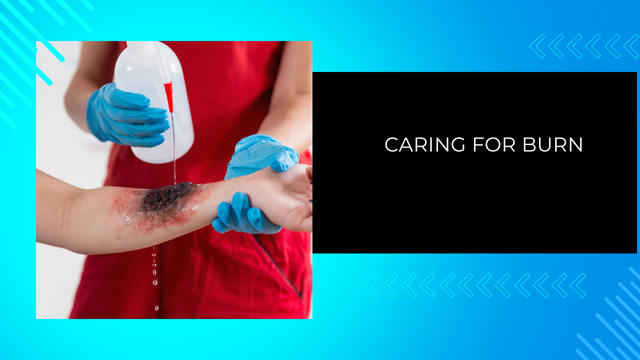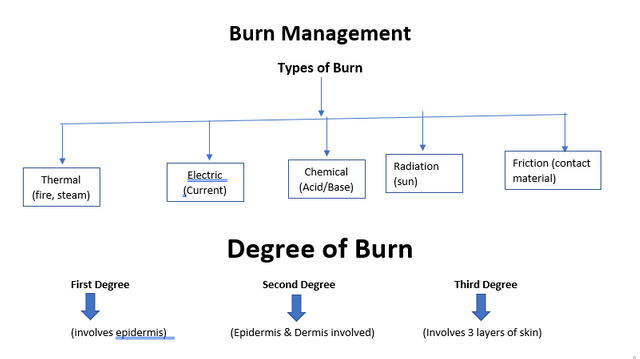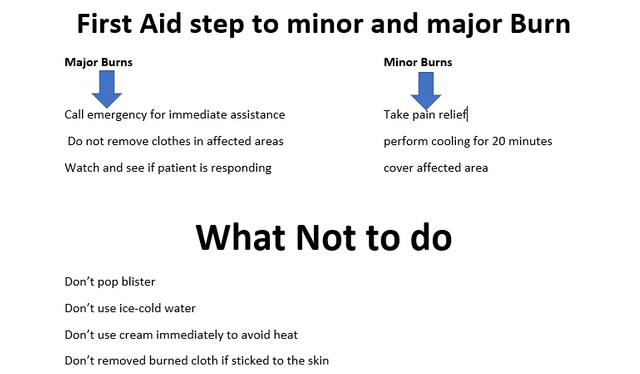Greetings dear friends, it's the last week of the Steemit Learning Challenge for this season and I'm delighted to share my participation in the contest organised here by this teaching team which they titled Understanding Burns: Types, Causes, and First Aid Responses. Going through the course material I noticed that it is knowledge packed and interesting and for that reason I will like to share my thought based on the questions given below.
.png)
| Q1:Write a detailed first aid response for the following scenario: " You witness a child accidentally spilling hot tea on their arm. What immediate steps will you take? What actions will you avoid? Include considerations for burn severity and explain your reasoning. " |
|---|
Based on the knowledge gotten from this lecture, seeing a scenario where a child accidentally spill hot tea on their arm the immediate step I tend to take are as follows. There are 6 basic steps to always take whenever such a scenario surfaces and I will be discussing them one after the other below.
Firstly, I will apply the DRABC which stands for Danger, Response, Airway, Breathing and Circulation. This is the first thing to do as a first aider. So how do I go about it? In applying DRABC what comes to my mind first is my safety and the safety of the child hence I will firstly move the child aware from where the incident happened so that future occurance as a result of trying to care for him won't happen again to him or to myself.
Secondly, I had to asses the situation to check the severity of the burn to know what degree of burn has affected the child. In checking the degree of burn I took into consideration the symptoms of the first, second and third degree of burns which include skin appearing reddish and dry, skin appearing reddish, blistered and swallen, skin appearing white, charred, wax for the first, second and third burn degree respectively. So in this observation I was able to determine the kind of burn that the child has.
Thirdly, seeing that the burn is a first degree one, I went ahead to apply cooling to the affected area by pouring water of room or normal temperature to the surface for about 20 minutes. In doing so, the pain which the child is facing will gradually subside and a little calmness will return to the child's body.
Fourthly, consideration that the hot tea spilled on the arm of the child and there is possiblity of the clothes attached to the skin in the burn area I decided to remove clothes around the affected leaving the place where the hot tea spilled because it has attached to the child and removing it may cause more harm than good.
When that was done I went ahead to observe the child and see his reaction as that will enable me to know if the act I carried out help subsided the pain or not. So seeing that the pain reduced after pouring the water of a room temperature for 20 minutes and removing everything around the affected area, I noticed that there was no call for alarm any longer.
Though in cases of second or third burn degree, a proper medical attention will be required to ensure that the patient gets treated so that the place doesn't get contaminated. In this case it is a minor thing and that is why the need of a medical practitioner is not needed.
What actions will you avoid?
In such a situation, there are many action to avoid so that you can reduce the severity of the issue and also bring calmness and relief the victim of the pains he/she is passing through.
The first thing I try to avoid is pouring cold (ICE) water in the area because the type of water that is needed in such a case is water of normal temperature.
Secondly, I avoided the break of blisters from the affected areas because breaking it will open the affected area to infection which will cause more harm to the patient.
I also tried to avoid the application of direct pressure to the affected area this is because applying pressure will cause more pains to the victim.
I also tried to avoid the application of creams, lotions and others immediately because they can cause heat in the affected area and that will lead to attraction of infection in the affected areas.
I will also ensure that I avoid tightening the affected area because in doing that I may be increasing the severity of the injury since it may hinder the free flow of blood within the system.
Include considerations for burn severity and explain your reasoning
Burning severity solely depends on the degree of burn that the victim is experiencing. So in the lesson we have 3 burn severity and they are as follows.
First Degree Burn: This type of burn is the commonest type of burn that we have as it only after the epidermis, it is less severe when compared to others and this type of burn can be treated with normal cooling method and may not need a medical practitioner.
Second Degree Burn: This is a more severe kind of burn than the first degree because it affects the epidermis and the dermis. These type of burn always occurs in sensitive part which may require medical attention to help solve it.
Third Degree Burn: The highest form of burn in the ranks is the third degree burn which is a most severe type of burn as it affects more areas than the case of the second degree and it always require medical attention and sometimes it requires surgery.
Reason: In all the types of burn explained above and the solution provided for each, you will notice that the major aim is to minimise the pain which the burn caused and possibly stop the infection that may occur from spraying to other parts.
| Q2: "A worker in a warehouse suffers an electrical burn after touching exposed live wires. The burn site shows entrance and exit points, with damage to the skin and underlying tissues. What are the immediate first aid actions you should take, and what critical steps should you avoid? How does this differ from treating thermal burns?" |
|---|
The immediate first aid actions to take in such a situation are as follows. Firstly, you must be sure that you are safe as well before attending to the victim and you will do that by ensuring you switch off the electric power so as to avoid being burn as well. If you have switched off the power and you are sure that touching the victim won't get you affected then you can proceed from there.
Secondly, checking the worker to confirm his state and this can be achieved by tapping on the shoulder of the worker and asking if he is okay. If he doesn't respond you will immediately call for help so that an urgent medical attention can be carried out on him but if he is breathing but pulse are absent then CPR can be done immediately to restore him.
The next thing to do is to cool the burn to reduce the pain of the worker. Unlike the thermal burn where water is used, here we will need to just cover the affected area so that it doesn't get affected and even more exposed. Also if bleeding is noticed, it should be controlled by applying little pressure around the area and also cover it to stop the bleeding.
.png)
Lastly, I will go ahead to monitor the worker to be sure if the worker is stable and if there is any relief from what I have done and if none I will immediately call in a medical practitioner to attend to the worker.
What critical steps should you avoid?
Firstly, I will avoid the use ice-cold water on the affected worker because such burn if you apply this type of water it may end up causing more harm to the patient.
I will avoid the use of cream substance in area of affected burn as this mostly generate heat and that causes they are to get more infected.
Removal of clothes around affected area should also be avoided as there are tendencies that the shock may have band the skin with it and removing it immediately will cause more pain to the patient. So cut around it and avoid touching infected area.
Always avoid touching the patient when the electrical power is still on. Ensure that it is well switched off before touching the body of the worker.
How does this differ from treating thermal burns?
The difference between the treatment of electrical burn and thermal burn can be seen in the table below.
| Electric Burn | Thermal Burn |
|---|---|
| This burn doesn't require water for cooling | This burn requires water to cool it |
| This burn is more risky when compared to thermal burn and for that reason it requires immediate medical attention | This burn doesn't require medical attention |
| This type of burn based on it severity affects internal organs | This type of burn affects only the epidermis |
| This burn has a potential entry and exit point which tells us the amount of damage it has | This burn only shows the damage place |
| Q3: "A worker in a factory accidentally spills a strong acid on their arm, causing immediate pain, redness, and blistering. A colleague tries to wash it off with water but notices the burn spreading." a. Identify the type of burn. b. What went wrong during the initial first aid? c. Propose the correct first aid steps and explain why each step is important. |
|---|
Considering the fact that the worker spills a strong acid on their arm, it means that the type of burn such worker has is the chemical burn. Recall that in the lecture we are told that chemical burn involves the spill of acid and base and this is thesame case. The spill as we see caused immediate pain, redness, and blistering which tells us that it is a second degree burn.
What went wrong during the initial first aid?
The initial first aid as we see was that the first aider applied water to the affected area which lead to the spread of the burn to other parts. Applying water to wash off the acid was not the solution here so it is an error already.
We noticed a more spread of the burn in other areas which means that the water served as a fuel to the fire already on the worker and that is what lead to it spreading.
The responses done wasn't inline with the solution needed for that type of burn and that is why there was an increase in the burn and affected area. So in my opinion that is what went wrong.
Propose the correct first aid steps and explain why each step is important.
Firstly, I will ensure safety of my self and the worker by removing him from further exposure to the chemical. This means taking him away from that area. I should put on glooves when doing this.
Secondly, I will cut around the clothes and remove anything adding pressure to affected area this is to help the affected worker to be more free and so that other areas don't get affected.
I will use distilled water which is a form of neutralizer instead of making use of normal water. Pouring distallied water to affected areas will lessen the pain and also stop further spread of the reaction.

I will also cover affected area with clean clothes to avoid infections. This is because leaving it open can attract some germs which may result to another thing in the victim.
I will also call for emergency so that a medical practitioner can check and profile more stable solution to the situation because it may need more medical attention. I will also check for responses while waiting for the medical team to arrive.
| Q4: You are a first responder in a rural area. Two people are injured in a house fire: Person A has a large area of third-degree burns but is conscious and calm. Person B has second-degree burns on both legs and is in severe pain. You can only help one person immediately due to resource constraints. Whom do you prioritize, and why? Support your decision with medical and ethical reasoning. |
|---|
This is indeed a serious case that needs to be careful looked upon. If I have two victims in which person A has a large area of third-degree burns but is conscious and calm and Person B has second-degree burns on both legs and is in severe pain and I can only help one person immediately due to resource constraints I will go ahead to help person B.
Now my reasons are not far fetched. The case of person A, he has a third degree burn which is the most severe type of burn and mostly it requires medical attention which may lead to surgery, in this case he is calm and conscious with less pain even though he may have had lots of damage which affected tissues and nerve. Based on the available resources I won't be able to carry out an operation and I'm not even a medical practitioner to do that. So this is outside my reach completely.
While calling on medical practitioner to come over, I will focus on person B because his case is such that it can it has serious pains and such pain can lead to shock and possibly kill the person if not attended to. So trying to stabilise the person B is something that is within my reach and that is why I chose to save the life of the one much visible to me.
Based on medical and ethical reasoning you will agree with me that my choice of attending to person B is very valid since person B is in more pain and that is they only one I can stabilise based on the resources constraints. Person A needs a medical practitioner which may require surgery and I have also called in the team to come take charge as I try to keep person B alive for their arrival.
| Q5: Create an infographic on burn management. Include the following: a. Types of Burns and Their Causes (Electrical, Thermal, etc) b. Different types of burns (1st, 2nd, and 3rd degree) c. First aid steps for minor and major burns. d. What NOT to Do During Burn First Aid." Use visuals and short explanations for each point. |
|---|
I want to finally invite a few friends to also share their participation in the contest if they haven't done that already. I invite @josepha, @suboohi and @dove11 to share their participation in this contest.



Student Name: @simonnwigwe
Overall grade: 9
Plagiarism Check: Pass
AI Use: no
General Feedback: The student has shown a good understanding of this week's course. I definitely enjoyed reading your article. There were a few shortcomings which I'm sure will be avoided in the upcoming posts.
Thank you.
Regards,
@huzaifanaveed1
Downvoting a post can decrease pending rewards and make it less visible. Common reasons:
Submit